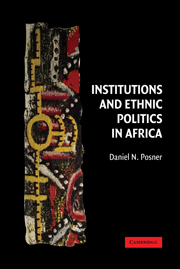Book contents
- Frontmatter
- Contents
- Preface
- INSTITUTIONS AND ETHNIC POLITICS IN AFRICA
- 1 Introduction
- I Introduction to Part I
- II Introduction to Part II
- III Introduction to Part III
- IV Introduction to Part IV
- Appendices
- A Native Authorities and Tribal Identifications
- B Survey and Focus Group Methodologies
- C Tribal Affiliations of Parliamentary Candidates
- D Tribal Demographics of Electoral Constituencies
- Bibliography
- Index
- Titles in the series
D - Tribal Demographics of Electoral Constituencies
Published online by Cambridge University Press: 05 June 2012
- Frontmatter
- Contents
- Preface
- INSTITUTIONS AND ETHNIC POLITICS IN AFRICA
- 1 Introduction
- I Introduction to Part I
- II Introduction to Part II
- III Introduction to Part III
- IV Introduction to Part IV
- Appendices
- A Native Authorities and Tribal Identifications
- B Survey and Focus Group Methodologies
- C Tribal Affiliations of Parliamentary Candidates
- D Tribal Demographics of Electoral Constituencies
- Bibliography
- Index
- Titles in the series
Summary
In a context where resources are assumed to be distributed along ethnic lines, and where the fairness of the current pattern of distribution is judged by the correspondence between the share of resources that each group controls and the share of the population it can claim as members, accurate information about the ethnic composition of the country's population can be highly inflammatory (Hirschman 1987; Diamond 1988; Wright 1994; Horowitz 1985). As Horowitz puts it: “Numbers are an indicator of whose country it is” (1985: 194). For this reason, questions about respondents' ethnic backgrounds are simply not asked in the national censuses of most developing nations.
In a striking departure from this norm (and for reasons I do not fully understand), the 1990 Republic of Zambia Census of Population and Housing collected data on the tribal backgrounds of census respondents. Although this information was not included in any of the descriptive tables published by the Zambia Central Statistical Office (ZCSO) – “respondent's Zambian tribe” was the only variable omitted from the otherwise comprehensive cross-tabulations – it remained in the raw data, which I was able to obtain from the ZCSO. This data set, which contains the self-reported tribal affiliations of 7,383,097 individuals, provided me with an indispensable (and unparalleled) source of information for the analyses that I undertake in this book.
- Type
- Chapter
- Information
- Institutions and Ethnic Politics in Africa , pp. 310 - 312Publisher: Cambridge University PressPrint publication year: 2005



